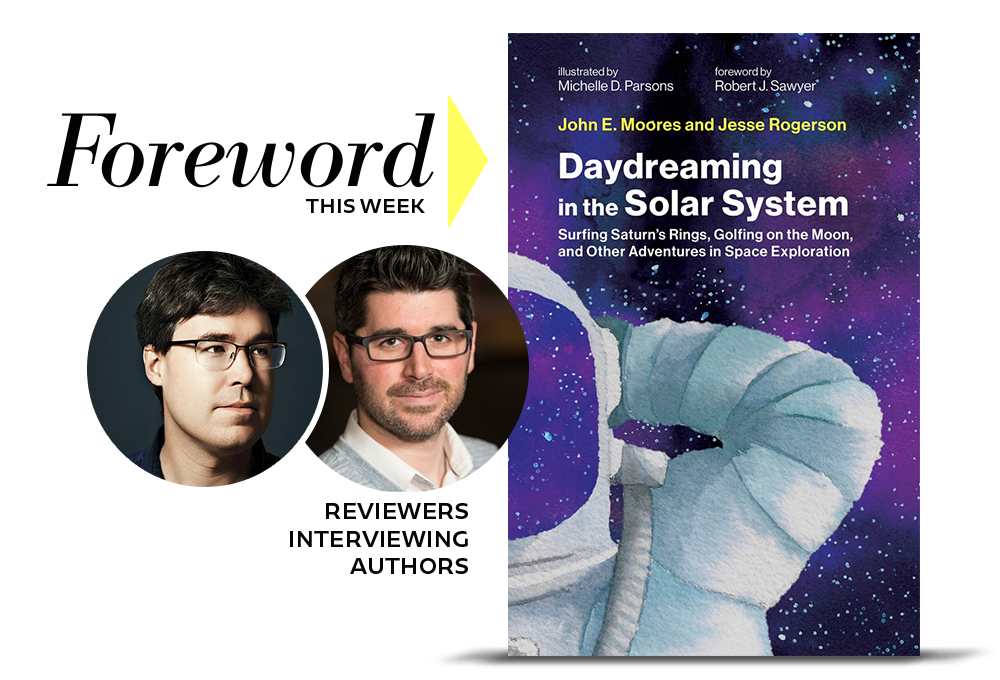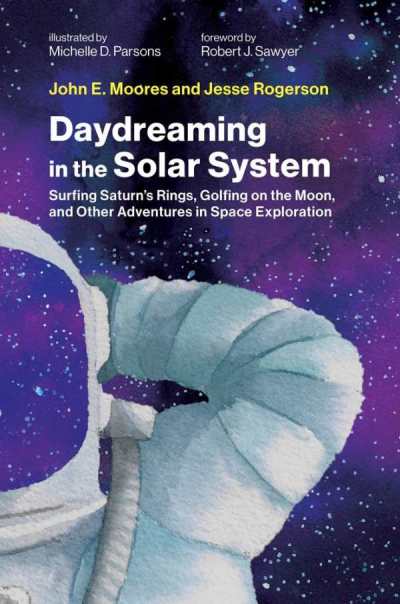John Moores and Jesse Rogerson Talk about Daydreaming in the Solar System: Surfing Saturn’s Rings, Golfing on the Moon, and Other Adventures in Space Exploration

“By weaving together storytelling, science communication, and visual arts, we hope that our approach [in the book] will help people expand their understanding of themselves and their place in the solar system. … Furthermore, by telling stories that emphasize the inherent value of other environments in our solar system, we hope that some readers may come to more greatly appreciate wild spaces on the Earth.’’
Complexity will eventually drive us mad—or worse.
Why? Because as technology progresses and science continues making breakthroughs, we will increasingly be forced to rely on experts and specialists to live our lives. But will we trust those experts to have our best interests in mind? Or, will we become increasingly distrustful and seek out versions of the truth that better fit our individual worldviews? To be sure, if we want to stay on good terms with our neighbors, we can’t all go in different directions.
Evolutionarily, it paid for us to be a skeptical species, suspicious of the new and the strange. But the current pace of change requires that we develop a newfound sense of humility. We must resign ourselves to living in a world that exceeds our ability to comprehend.
But another fact about our evolution as a species is that we love a good story. And if we consciously choose to embrace stories that bring us peace and understanding, as well as knowledge and factual information to better ourselves, all the universe’s complexity will be much less overwhelming.

Astrophysicist Jesse Rogerson and planetary scientist John Moores are with us today to talk about how they embraced the role of storytellers to write about some of the most complex scientific topics of all.
Their Daydreaming in the Universe—reviewed by Kristen Rabe in Foreword’s November/December issue—offers a splendid model for other writers to use story and imagination as a means to bringing the biggest ideas down to earth.
We also reviewed The Apothecary’s Wife (PDF here) in that November/December issue; it’s another great science project that will appeal to lovers of a good story. Discover other notable titles from indie publishers by signing up for a free digital subscription to Foreword.
Daydreaming in the Solar System cleverly integrates fiction with science to describe conditions on various planets, moons, and other celestial bodies. What inspired this engaging approach? How does the inclusion of fiction help you achieve things you couldn’t otherwise?
The inspiration for this approach came about organically. We wanted to create something that married the best of both worlds: the engrossing engagement of science fiction combined with the precision of science fact. The inclusion of fiction has huge implications for connecting with other people. Humans communicate, talk, and see themselves through story; some have even called us “The Story Species.”
We are always telling stories to each other or to ourselves, and story is one of the most effective ways to learn new information. By wrapping our science communication goals with narrative fiction, we can connect with the reader on a much deeper level, evoking the kind of awe that we experience in nature.
We also wrote the book in the second person, to explicitly invite the reader to envision themselves as the protagonist of these stories.
Most of your fictional scenarios depict sports like golfing, rappelling, spelunking, and sailing. Why did you choose physical activities to illustrate scientific facts about these locations?
By describing physical activities, we’re helping the reader imagine what it would be like to physically interact with each place and experience these environments with all the senses. Our book’s illustrator also appreciated having dynamic activities to depict. When you visit a national park, you’re usually there to do something physical. It might be a trek, a rappel, a paddle, or one of a million other ways to be immersed in—and interact with–nature.
We also wanted to capture the stillness found in nature. The Apollo astronauts described a similar mix of sensations: They were doing work on the moon but also enjoying the environment. Alan Shepard brought a makeshift golf club and Buzz Aldrin reported being overcome by what he called “the magnificent desolation” of the landscape.
The environments you describe are remarkably diverse—from the murky, layered seas of Titan to the barren, cratered surface of Mercury. How can such diversity exist within the relative proximity of a single solar system?
That is a fascinating point. Carl Sagan once said, “These are a few of the things that molecules (or hydrogen atoms) do, given four billion years (or fifteen billion years) of evolution.” He meant that all the beautiful complexity we see in the universe, including life, arises from fairly simple physical rules.
Our solar system started out with a blend of hot gasses interspersed throughout the solar disc. But very quickly these gasses separated out into zones because it’s warmer near the sun and colder further away; since the condensation temperature of each molecule is different, each molecule is most stable at different distances from the sun. This is why you find so much ice in the outer solar system where it is cold and so much rock in the inner solar system where it is warmer.
Once those molecules condense and clump together to become planets, things can change further. Smaller planets don’t have enough gravity to hold on to the lightest molecules, like hydrogen in their atmospheres over billions of years. But those that are big enough and cold enough can retain very thick atmospheres. Those atmospheres, in turn, allow a rich variety of processes to occur on the surface of that planet and in that planet’s atmosphere. But if the planet is too big, it will keep so many of these light molecules that it will have no surface at all, like on Jupiter.
These two principles—the size of a planet and its location in the solar system–explain a surprising amount of the variation we see in planetary environments.
By making astronomy so accessible, your book will appeal to a wide audience. Which types of readers did you have in mind?
Thanks for asking! We’re hoping to appeal to fans of science, as well as those interested in science fiction. The book is designed to be accessible to anyone interested in learning more about the solar system, starting with high schoolers and up as the target audience. The stories are quite meditative, so they may also appeal to those looking for calm, say as nighttime reading.
While we intend for the stories, the science, and the art to be consumed together, different readers will gravitate toward one or another part of each chapter or the visual elements. Those who like math and physics will find something here—as well as those drawn to visual depictions or exploration. This interweaving is intentional. John’s enjoyment of speculative fiction informs his science; Jesse had considered art school before going all in on science communication; and Michelle (book illustrator) began her professional life in engineering before becoming a watercolour artist. We wanted our book to represent these different pathways and combinations of story elements.
Of all the places you depict, which would be considered the most Earth-like? Which the least Earth-like?
It’s challenging to pick just one. In terms of temperature and pressure, the most Earth-like environment is within the clouds of Venus. In this story in our book, the protagonist doesn’t even need a spacesuit (though they still need oxygen and a coat that is resistant to sulfuric acid!). But living in the sky is also very unearthly, so Mars with its similar day length and familiar desert landscape would likely feel most Earth-like to a visitor, even if they do need a pressure suit to survive here.
For the least Earth-like, it’s a question of which dimension of strangeness seems most disorienting to any particular reader. For us, the airless bodies offer so few human touchpoints that they seem the most unearthly, especially the small ones that have strange shapes and very little gravity. The comet with its changing icy landscape is one example, as well as the asteroid we depict, or the rings of Saturn.
The book raises so many fascinating questions about the nature of life and the universe. Do you hope this book will encourage readers to view themselves or our own planet differently?
Yes, absolutely! By weaving together storytelling, science communication, and visual arts, we hope that our approach will help people expand their understanding of themselves and their place in the solar system. Perhaps some might even consider participating in space exploration. There are many ways to do this, not just as an astronaut.
Furthermore, by telling stories that emphasize the inherent value of other environments in our solar system, we hope that some readers may come to more greatly appreciate wild spaces on the Earth. Certainly, the book makes it clear that there’s no place within our solar system as welcoming or as precious as Earth.
Kristen Rabe
